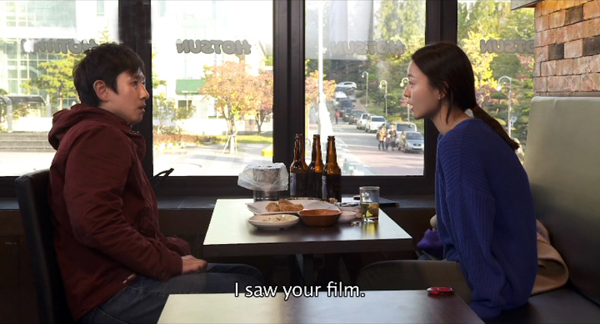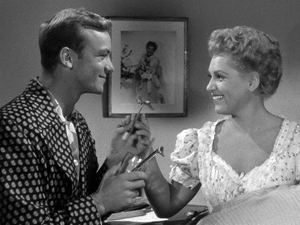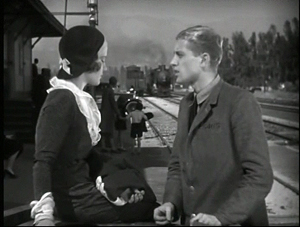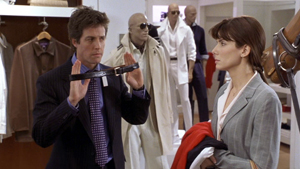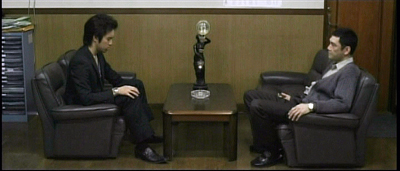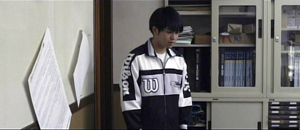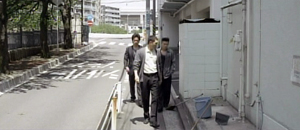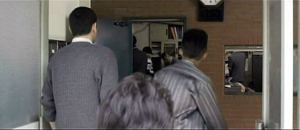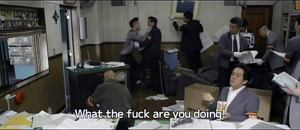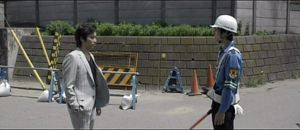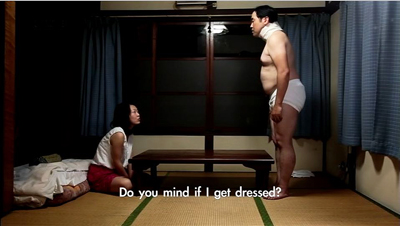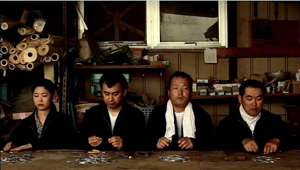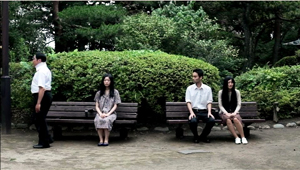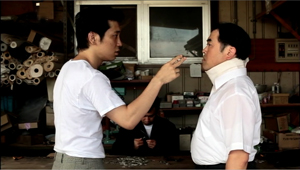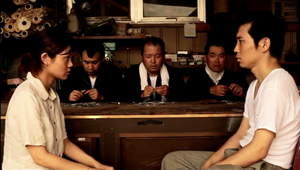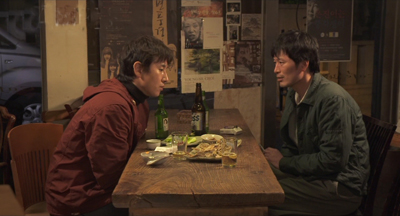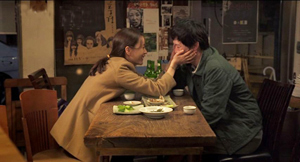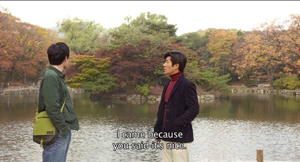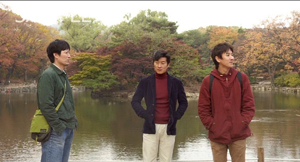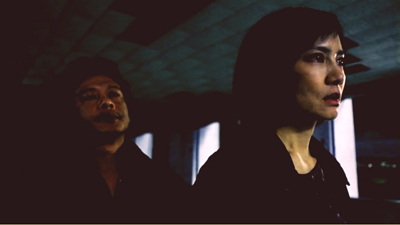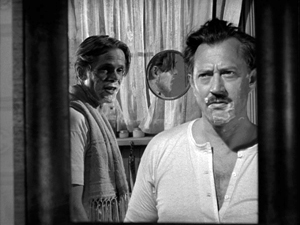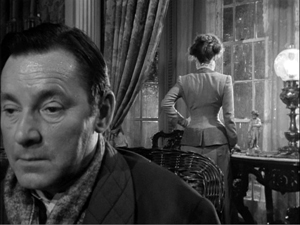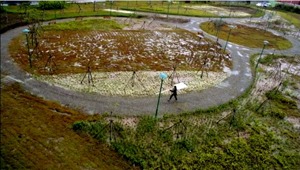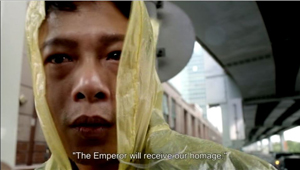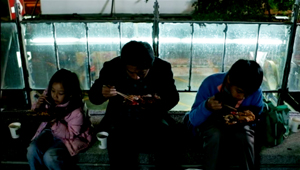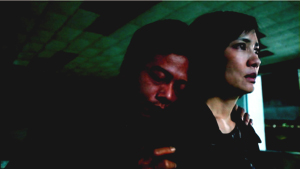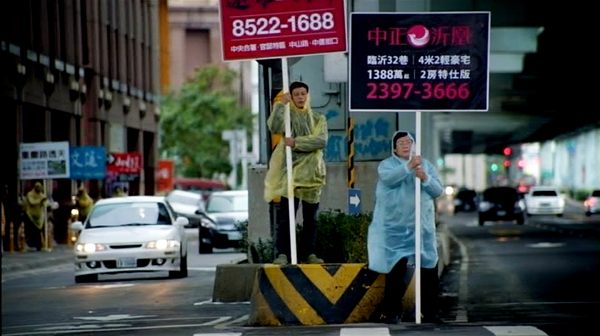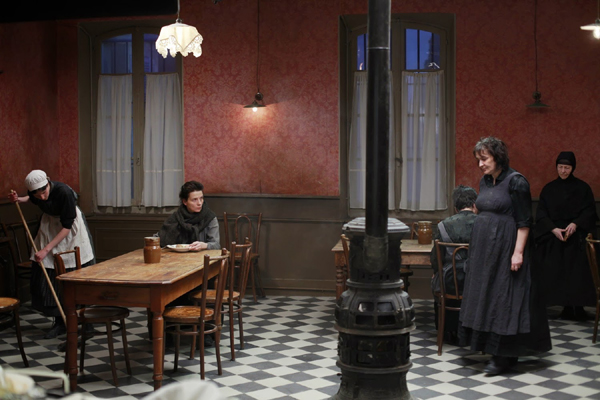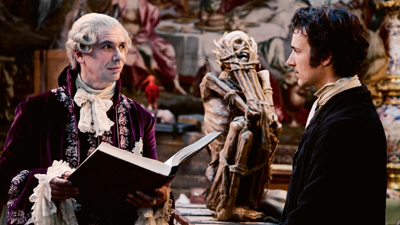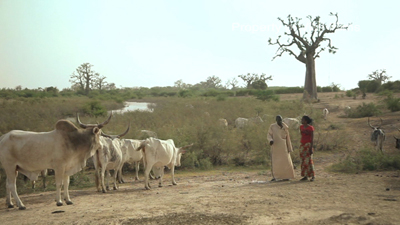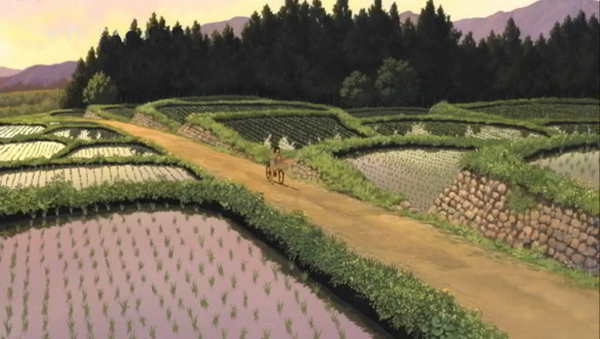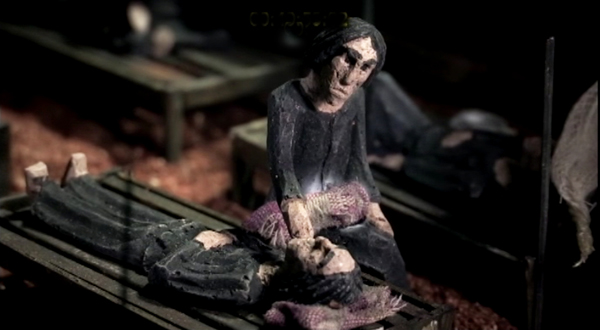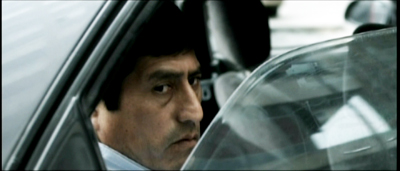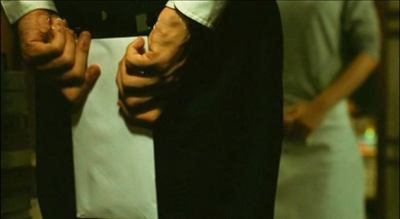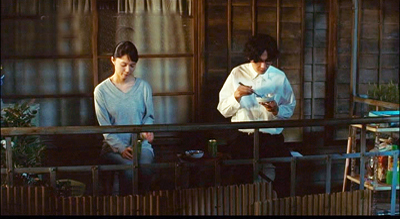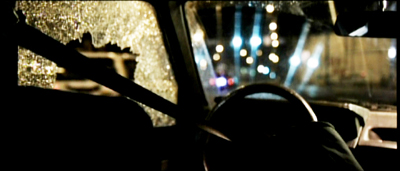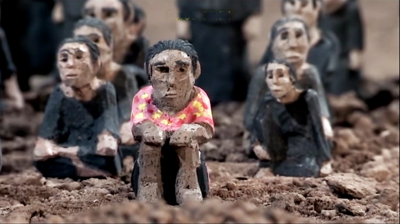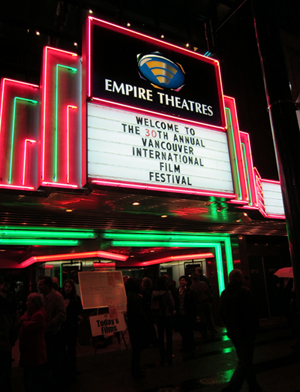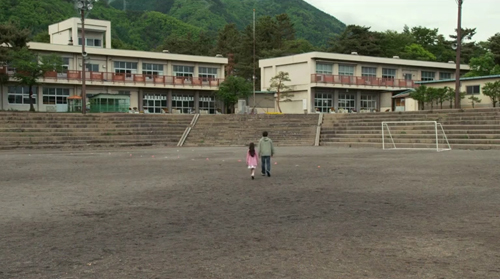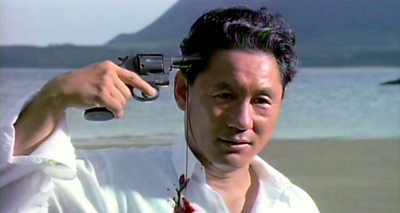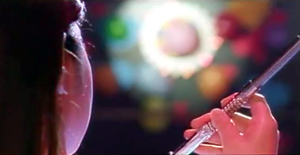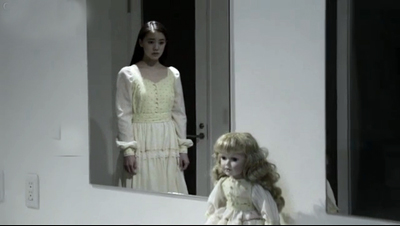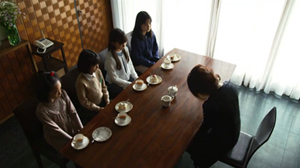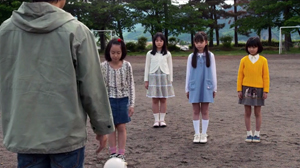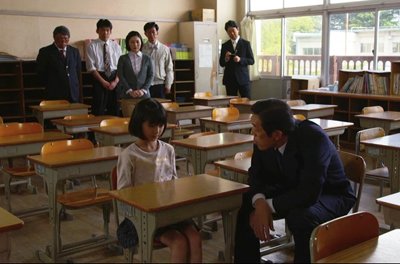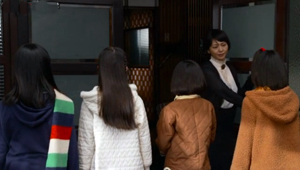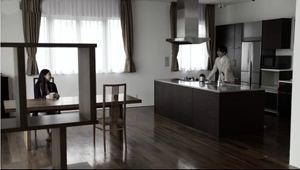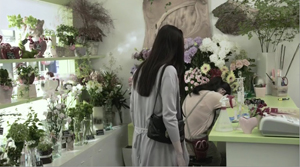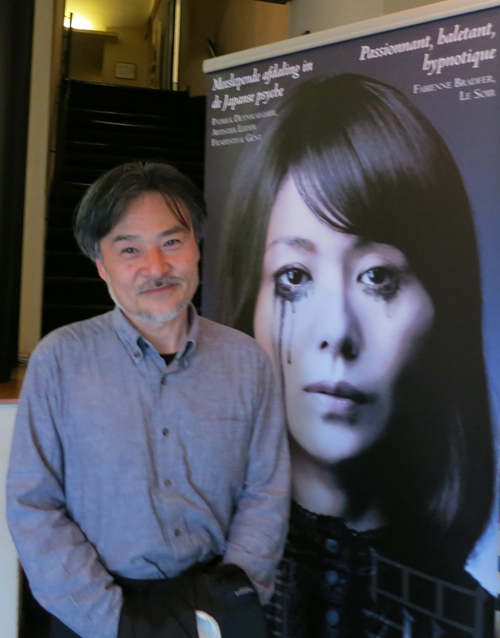Archive for the 'National cinemas: Japan' Category
Where did the two-shot go? Here.
Our Sunhi (Hong Sangsoo, 2013).
DB here:
I’ve complained here and there about the rudimentary staging of scenes in mainstream American movies. (Short version of common practice: Cut a lot and move the camera instead of moving the actors.) But just as rare as complex staging, in the age of intensified continuity cutting, is the sustained and stable two-shot.
Two actors exchanging lines in a continuous, unmoving take was one building block of mature sound cinema. Today’s directors almost never resort to it. Their face-offs are “given energy” by a drifting or arcing camera, or lots of cuts, or, if they feel like moving the actors around, the Steadicam walk-and-talk.
But the prolonged, balanced two-shot can yield remarkable results. A medium-shot or medium-long-shot framing can work to a human dimension, giving prominence to the actors’ bodies. It doesn’t let their surroundings swamp them, and it doesn’t reduce them merely to faces. It lets the actors act with not just facial expression but with their posture and their upper bodies. And it nicely balances dialogue with the flow of pictorial information. We can watch both actors, with one reacting to the other, as in The Marrying Kind (1951).
Sometimes the two-shot is played with the faces in profile, as in early sound pictures like The Criminal Code (1931).
But directors quickly understood that if you prefer, you can angle the actors so that we get a 3/4 view of one or both. The tactic sacrifices realism (who stands in such ways in real life?) but it’s a piece of artifice we gladly accept. It’s visible in my Marrying Kind example, as well as here in Two Weeks Notice (2002).
Of course two-shots are still with us, but they usually serve to set up passages of shot/ reverse-shot cutting. The sustained two-shot carrying long stretches of dialogue is increasingly rare in Hollywood cinema. It surfaces more often, I think, in indie works (Jarmusch, Linklater, and Hartley, for instance), European films (Garrel, for instance), and perhaps most notably some Asian films.
For reasons not yet well understood, during the 1980s stylistically ambitious directors in Japan, Taiwan, and China began building scenes out of long, static takes. Sometimes those are distant framings, unfolding in elaborate blocking; to my mind Hou Hsiao-hsien is the great master of this. But no less prominent are those films that present simply staged shots of two or more characters in which action and reaction are captured by a fixed camera. Often these shots avoid 3/4 views. That is, we may get two characters in profile, or two characters facing the camera directly. The result is a more abstract, even ceremonial look and feel.
I was remembering this tendency while watching several of the films on display here at the Vancouver International Film Festival. I saw one film very largely made of two-shots. I saw a couple in which the two-shots serve mostly as points of punctuation, breathing space between scenes that are cut up in more orthodox ways. And I saw one film that climaxed in a two-shot showing the actors holding their ground for about fourteen minutes. All were from Asia.
Both visual and plot-based information follows; in other words, as often happens hereabouts, there are spoilers.
The Return of Kids Return
Kids Return: The Reunion, directed by Shimizu Hiroshi, is a sequel to Kitano Takeshi’s 1996 film. The disaffected high-school buddies Shinji and Masaru were last seen riding a bike and declaring that they would show the world what they’ve got. Now, many years later, they haven’t shown much. Masaru is a low-level gangster who has lost the use of his left arm in a jailhouse brawl. Shinji holds a boring job as a security guard, and he’s about to give up boxing. The two meet by accident and resume a more distant version of their friendship. Masaru gets more deeply embroiled in the yakuza world, but he does convince Shinji to stick with prizefighting. As Shinji struggles to improve his skill, Masaru sets out to avenge his betrayed boss, with murderous results.
The new version doesn’t have the dry, laconic quality of Kids Return, and the film doesn’t employ Kitano’s characteristic planimetric framing and compass-point editing. But the incessant over-the-shoulder framings of most movies are avoided; when we cut to a character, he or she is usually isolated in the frame. And some moments recall the cartoon-panel cutting of Kitano. One scene shifts from the yakuza boss, Masaru, and the thug Yuji in a coffee shop to a soundless shot of their young subordinate at the office simply staring off into space. Cut to the three men strolling back to the office, with Yuji commenting that the kid never keeps the sidewalk clean.
A pan following the men into their building shows the office open and men inside. Yuji bolts past his boss and flings himself at a policeman, who is one of several ransacking the place for evidence.
Most directors wouldn’t include the enigmatic shot of the functionary, but it yields a little question–what is he reacting to?–that the next shots gradually answer.
So cutting plays an important part in building up many scenes. But occasionally Shimizu pauses to draw a moment out. When Murasu and Shinji meet after many years, a nearly thirty-second shot squares them off.
Instead of embracing and pounding each other’s back in the American fashion, they stand awkwardly opposite each other, and the anamorphic widescreen image stresses the tentativeness of their reunion. Later, when Murasu’s boss suggests he leave town and work for another boss, a poised two-shot (at the top of this section) lets us watch the interplay between them across two minutes. Again, the ‘Scope ratio helps, and the fixed frame adds a comic touch by setting at frame center the hideous, ticking clock that Yuji has bought the boss.
I don’t want to suggest that there’s anything particularly radical about Shimizu’s two-shots. Kids Return: The Reunion simply reminds us that a two-shot can usefully vary the film’s pace and lend gravity to moments of character reflection.
Absurdist anatomy
Something stranger goes on in Anatomy of a Paperclip, the winner of the Dragons and Tigers Award here at VIFF. The story is an exercise in grotesque nonsense, a sort of Japanese Theatre of the Absurd.
In an undefined town outside time (no cars, videos, or cellphones), a harsh boss rules over a crude cottage industry. Three, sometimes four, workers sit along a bench and make paper clips by snipping and twisting wire. The most hapless is Kogure, a lumpish loser wearing a neck brace. Bullied by two outlaws who constantly make him surrender his money and take off his clothes, eating with painstaking regularity in the same cheap restaurant, he returns home every night to sleep. A butterfly visits him and apparently leaves a pupa behind. As Kogure trudges through his days of petty humiliations, the pupa swells to human size, even bigger than the pods in Invasion of the Body Snatchers.
Director Ikeda Akira shot the film in fifteen days over weekends and holidays. It’s partly in the planimetric mode, with the camera lined up perpendicular to a back wall or lines in the setting.
Even more than Kids Return, the mug-shot and police-lineup staging recall linear, minimalist manga. A great deal of the film’s feel, that of a frozen, almost robotic world, derives from this deliberately “flat” look.
In Anatomy of a Paperclip, the profiled two-shot functions as part of the overall visual pattern. Although some conversations show 3/4 views of the characters, and even yield occasional OTS (over-the-shoulder) framings, many two-shots preserve the geometrical right angles of the master shots.
Another function of our two-shot, then: To play its part in a film’s overall pictorial design, suggesting expressive qualities like rigidity, automatism, and deadpan humor.
Two’s company, four’s a crowd
Hong Sangsoo has made the two-shot–usually profiled and showing characters drinking heavily at a restaurant table–into a central formal device. His films are conversation-driven, and he has rung an ingenious series of variations on duologues. They are typically presented in ways that stress similarities and contrasts among characters, often to mildly satiric effect. We see A and B in one setting, then perhaps B and C in another setting, then A and C in the first setting, and so on. For examples, see this entry.
In the more formally complex Hong films, these variants may be played out as intermingled points of view (The Power of Kangwon Province) or as alternative versions of the same events (The Virgin Stripped Bare by Her Bachelors) or just weird déja-vu (Turning Gate). In an earlier entry, I suggested that Hong exploits our inability to remember certain things precisely, so that we may forget when we first heard a recurring line of dialogue or saw a shot that is echoed by the shot we’re now seeing.
Our Sunhi is about a hugely momentous event that hasn’t, to my knowledge, been dramatized on film before: a professor writing a grad-school recommendation. Sunhi approaches Professor Choi for a reference that will help her study in the States. As she coaxes him into revising his initially cool letter, he becomes attracted to her, as does another university employee Jaehak. Meanwhile Sunhi meets her old lover Munsu, and he becomes attracted to her all over again.
Here the formal rondelay that mocks male vanity–a Hong specialty–doesn’t involve fancy tricks with time or parallel viewpoints.Instead, what circulates are comments about Sunhi, pulled from the professor’s letter (“She has artistic sense,” “She’s honest and brave”) and passed from man to man. The points of circulation come in eleven duologues, each shot in one or two symmetrical long takes. Sunhi meets Jaehak, then Choi, then Jaehak again, then Munsu. Soon Munsu is going out drinking with Jaehak, with whom the prof has coffee before having a rendezvous with Sunhi. Connecting these nodal scenes are brief shots of characters walking through streets, meeting one another by accident, and at the finale, converging in a palace park. As you’d expect, these connecting bits are typically made parallel to each other through framing, situation, music, or other devices.
The two-shots are very long; the longest runs over eleven minutes. It presents a sort of climax, in which a drunken Sunhi reaches out to clutch Jaehak–a gesture of greater intimacy than she has shown any other man.
But soon enough she is meeting the professor for a date in the park. In the very last scene, when she goes off to the toilet, Hong gives us a tiny joke. All three of the men finally meet, waiting for her, and at last a two-shot becomes a three-shot.
This sheerly formal gag is pretty esoteric, I grant you, but it’s typical of Hong’s urge to tweak the simplest materials. In his hands, the lowly two-shot becomes a structuring constraint, a way of deliberately limiting his choices to show us what he can do with it–not least, comic variation.
Two heads, better than one?
During the 1940s, directors in various countries began to rethink the layout of their two-shots. Instead of giving us matching profiled or 3/4 views, they began to arrange their players so that one figure was significantly closer to the camera, yielding what I’ve called a big-foreground composition. In America, the most flamboyant early versions came from Orson Welles (Citizen Kane and The Magnificent Ambersons) and William Wyler (The Little Foxes, below). This strategy encouraged staging in depth and even letting players turn their backs to one another.
Tsai Ming-liang’s Stray Dogs is the most elliptical and visually variegated film of this VIFF bunch. It’s less a story than a situation: A father, mother, and two children try to survive on the streets. The father picks up odd jobs, while the mother finds work in a supermarket. They wash in public restrooms and scrounge castoff food, sometimes thanks to the mother’s rescuing market goods past their sell-by date. At night, the father and the kids huddle in a makeshift hut, until the mother finds a somewhat better squat in a ruined office building.
Every scene except one consists of a single take, but the connections between scenes are far more oblique than in the other films in this entry. For instance, the mother is seen weeping beside her sleeping children in the opening shot, but then she vanishes from the plot for a while before reappearing in the supermarket, now with her hair cut shorter. The clear and continuous duration of the scenes is offset by a narrative organization that skips over a lot of time and refuses to explain everything that happens in the interim.
Tsai’s visual strategies are quite diverse. Unlike Hong Sangsoo and others in this trend, he doesn’t always keep his camera within a mid-range zone. A scene’s single take can be a striking extreme long-shot or a tight close-up, often of the father (played by the still remarkably waif-like Lee kang-sheng) eating, drinking, or just reciting a poem.
Stray Dogs makes little use of two-shots, and his “clothesline” layouts aren’t quite as frieze-like as those in Anatomy of a Paper Clip.
He saves his devastating two-shot for what is, in this quiet and melancholy drama, as close as we get to an intimate climax. The image at the top of this section shows the husband and wife, her face looming in the foreground while he stands behind her.
Why is this shot, only three minutes longer than one in Our Sunhi, so fiercely hard to take? Hong Sangsoo fills his restaurant shot with gab and plot development. Tsai’s shot, reminiscent of the big-foreground compositions of Welles and Wyler and many afterward, is almost completely unchanging. Neither husband nor wife speaks for fourteen minutes; the only action we see in most of the shot consists of him occasionally swigging alcohol from the bottles he’s stolen and some tears running down her cheek. And we have no idea of when the shot will end because there’s no obvious trajectory set up for it. Like the fixed close-up of a weeping face that ends Tsai’s Vive l’amour, this shot could go on forever.
About thirteen minutes in, the husband grasps his wife’s shoulders and leans his head wearily against her neck.
In a context scoured of what we normally think of as drama, such tiny movements become major events. The father seems at once apologizing for his drinking and trying for a reconciliation.
Tsai has reserved his two-shot for his climax. Instead of becoming a resource judiciously salted through the film (Kids Return: The Reunion) or a stylized extension of a cartoonish world (Anatomy of a Paper Clip) or a core schema for the film’s visual design (Our Sunhi), the two-shot here, rendered as an aggressive image of faces close to the camera, becomes the marker of a mysterious turning point in two lives.
All the films are very much worth seeing for their own reasons. Treating them together, though, reminded me of the power lurking within one very basic cinematic resource.
Last year I considered long-take shooting and staging techniques in that edition of Dragons and Tigers, with comments on Tsai Ming-liang’s Walker.
Just in case this occurred to you: No, Wes Anderson didn’t invent these techniques. This entry and some others explain.
For more on varieties of staging, see On the History of Film Style and Figures Traced in Light: On Cinematic Staging. On this site, you can visit the supplement to Figures here, and the categories Film Technique: Staging and Tableau Staging.
Stray Dogs.
VIFF: Maps, math, madness, and more
Camille Claudel, 1915.
Kristin here:
We’re halfway through the Vancouver International Film Festival, as we continue to catch up on world cinema in one dizzying ten-day swoop. Here’s a handful of worthwhile films I’ve seen so far.
Another “brave” performance
Critics speak of “brave” performances as those in which the role calls for an actress (seldom, for some reason, an actor) to allow herself to look ugly and awkward or to participate in explicit set scenes. The word got tossed around a lot this year in regard to the two young actresses in Blue Is the Warmest Color, this year’s Palm d’Or winner at Cannes. David and I saw it here and found it disappointingly conventional.
Juliette Binoche’s performance in Bruno Dumont’s Camille Claudel, 1915 (2013) has her eschewing makeup and playing the haggard, aging inmate of an insane asylum. Historically, Claudel was a sculptress and Augut Rodin’s lover before being placed in the asylum by her family. As the title suggests, we see only a small slice of her life, after she has already spent a good deal of time in the asylum, a laudably humane one set in a Catholic nunnery in the mountains.
For much of the film, we stay with her, registering both her annoyance at the antics of her fellow inmates and her compassion for them. She seems to suffer from a persecution complex, cooking all her own food and eating apart from the others (above) through a fear of being poisoned. She attributes her incarceration to Rodin’s and his colleagues’ schemes to steal her studio and sculptures. We have no way of knowing how much of this is true, and hence no way of knowing whether she is really unbalanced enough to be in an institution with incurable cases. Her occasional visits to the complex’s church and her communing with nature help to sustain her.
Well into the film, there is an abrupt point-of-view switch to her brother, the author Paul Claudel, as he pauses en route to the asylum in order to pray. We soon realize that he is a religious zealot, utterly devoted to his own view of Catholicism. The contrast between his dogmatism and Camille’s simple religious sincerity bodes ill for her hopes that he will arrange for her release.
Camille Claudel, 1915 is currently available only on unsubtitled French DVD and Blu-ray.
Math and maps
I am a fan of maps and of scientific exploration of exotic places, and Detlev Buck’s Measuring the World (2012) promised to deal with both in 3D. It weaves together fictionalized accounts of the exploits of two contemporaneous geniuses of the early 19th century: world explorer Alexander von Humboldt and mathematical genius Carl Friedrich Gauss.
I had high hopes for the 3D, imagining scenes a bit like the scene where Michael Fassbender plays with dazzling holograms of space maps in Prometheus–toned down a bit and more scientifically grounded, of course. Unfortunately there was nothing of the sort, with the 3D being used more conventionally for creating depth in the playing space, with branches in the foreground of shots in the Amazonian jungle and that sort of thing.
The film turned out to be a rather rollicking depiction of the two careers. The conceit is set up that Karl Wilhelm Ferdinand, Herzog von Braunschweig provided financing for both Gauss and Humboldt. He is caricatured (above) as a frivolous, silly man who reacts in utter incomprehension when handed Gauss’s first book on mathematics–as who would not at the time, given that it introduced startling new insights that revolutionized the field? Ferdinand was in fact a highly educated military man, and he never supported von Humboldt’s work.
Still, the eccentricities of the two seekers of knowledge are entertaining, the scenes of von Humboldt seeking specimens in the Amazon and on into the Andes are exotic, and the whole thing conveys something of the enthusiasm lingering as the Age of Enlightenment was coming to its end.
Measuring the World is available as a region-coded import with English subtitles under its original title Die Vermessung der Welt on DVD, Blu-ray, and Blu-ray 3D.
An African Charmer
The Senegalese film, Tall as the Baobab Tree (2012), is the first feature of a young white filmmaker, Jeremy Teicher, who first visited the village in which the film is set when he was 19 and making a documentary about it. Based on stories of village life he was told at that time by young students, he made Tall as the Baobab Tree at age 22. The local people helped with the script and acted in the film.
As with many African films, the subject relates to a traditional custom which has come in modern times to be viewed as a problem. It reminds me of Ousmane Sembene’s last feature, Mooladé (2004), which dealt with how a village’s women began to resist the practice of genital mutilation. Tall as the Baobab Tree concerns the practice of selling young daughters into marriage.
The story centers around Coumba, a teenager who has just passed her school exams. Her older brother falls from a baobab tree (the one seen looming above the scene above), and to pay for his medical costs, the father decides to sell Debo, the younger sister, into marriage. Coumba secretly works as a maid in a nearby resort to pay the costs, but although she succeeds in raising most of the money, the local village elder insists that custom dictates that the promised marriage must go through.
Although the father and village elder are clearly seen as in the wrong, they are not made into villains but are seen as stuck in the patterns of outdated traditions. Much emphasis is put on the education that Coumba has benefited from and that Debo will never experience. A touching scene near the film’s beginning shows Coumba among the students waiting in a group as the names of those who have passed their exams are read out. Clearly this was an actual event captured by the filmmaker, and the joy of the successful students effectively emphasizes education as the means to defeat the more oppressive remnants of tribal traditions.
Teicher describes his experiences and approach in collaborating with the villagers on the film in an interview on the BFI website.
Beyond Ghibli
The films of Miyazaki Hayao (Kiki’s Delivery Service, Spirited Away) and his colleagues at the Ghibli animation studio are the heights of Japanese animation. Beyond them, we in the west tend to know of other Japanese animated films as more simply made anime, with lots of violent action. But, as the program notes state, “it’s time to expand your horizons.” Hosoda Mamoru’s Wolf Children (2012) somewhat resembles the Ghibli films in genre, being a fairy-tale-like fantasy set in the present day.
Hana, a student, is attracted to a young man, Ookami, who decides to sit in on one of her classes. She offers to share her textbook, and as a romance develops, she discovers that Ookami is a shape-shifter, able to change into a wolf. After they have two children, Ookami is killed while in his wolf form. His children have inherited his ability, and Hana moves to a house in the countryside to hide their peculiarities from prying eyes.
The story follows the daughter, Yuki, as she decides to go to school and follow the human half of her nature, and the son, Ame, as he prowls the surrounding forests and mountains, communing with wolves he discovers there. The result has an environmental theme similar to that underlying some of Miyazaki’s films, with particular sympathy for the perpetually hunted wolves.
While the figure animation here is not as subtle as that of the Ghibli films, the settings are beautiful and detailed, with highly textured portrayals of the roiling movements of large cumulus clouds and the rustling of countless leaves in a forest.
Wolf Children looks great on the big screen, but if you can’t catch it in a theater, it’s due out in the USA on November 26, available on DVD or a combination Blu-ray/DVD set.
Wolf Children.
VIFF extremes
The Missing Picture (2013).
DB here:
The Vancouver International Film Festival, known to all as VIFF, has been undergoing some big changes. It lost its primary venue, an ageing but cozy multiplex surrounded by pubs, creperies, music clubs, and other marks of downtown culture. Alas, the Empire Granville 7 is now shuttered, to be renovated as a retail space. VIFF must spread its bounty more widely.
As before, films are shown at the Cinematheque and the Vancity media center. The new venues include the Vancouver Playhouse, the Rio Theatre, three screens at the Cineplex Odeon International Village, the Vancouver Centre for the Performing Arts, and the Goldcorp Centre for the Arts at Simon Frazer University. All the ones we’ve visited have been excellent screening spaces.
Everything we’ve seen has been on some form of video—excuse me, “digital cinema.” Apart from the occasional 35mm or HDCam show, DCP projection, after a couple of years of teething pains, is the norm. Not that this guarantees uniformity. Albert Serra’s Story of My Death, a peculiar portrait of the elderly Casanova, still looked (probably intentionally) like it was shot on VHS. The furor about festivals’ conversion to digital formats, discussed in this 2012 blog entry and extended in my little e-book, belongs firmly to history. Henceforth film festivals will be file festivals.
Genres plain and fancy
El Mudo.
As usual at VIFF, the range is wide. At one end of the scale is a feel-good dramedy like The Great Passage, Japan’s Academy Award entry. The central character is Majime, a shy and unworldly young linguist who is drafted to help create a dictionary of Japanese as a living language. An otaku when it comes to words, he soon devotes his life to fulfilling the mission. Over the years he manages to find a girlfriend and earn the respect of the elders steering the project and the friendship of a ne’er-do-well colleague who prefers alcohol to etymologies. The dweeb Majime, despite his sweater-vests and sleeve protectors, becomes moderately sociable, while his pal acknowledges that his own commitment to a geeky endeavor shows he’s not as cool as he thought.
The English title is misleading; a better one might be Crossing the Sea of Language, since the central metaphor is that of charting the ebb and flow of usage. The process is dramatized by setting the start of the project in 1995, before Internet 2.0. The professor overseeing the project points out that the arrival of the Web speeds up language change. The Net works its way into the plot, as card-based research gets replaced by algorithms and word searches. A lot of the film’s humor arises when sequestered scholars, like those in Ball of Fire, have to figure out what this younger generation means when it calls something bad (i.e., good).
Ishii Yuya, who brought to VIFF Sawako Decides (2010) and Mitsuko Delivers (2011), tells his heart-warming story in a trim, efficient manner. His composure could teach our Hollywood directors a thing or two. I didn’t see a wasted shot or gratuitous camera movement, and you might miss Ishii’s virtuoso handling of a crowded office space as volunteers pack in to beat the deadline.
You can often spot a director’s skill in delicate touches. Here, I admired a gentle hook between two scenes. Majime has written a florid, anachronistic letter to Kaguya declaring his fondness for her. At the end of one scene he walks away from the camera clutching the note, which the framing centers on. Cut to a distant shot of him with Kaguya, the letter a small detail alongside his left leg.
Most viewers, I’m convinced, scan to find the letter and then wait with an amused tension for Majime to awkwardly offer it. It’s a good example of gradation of emphasis: No need for a close-up at the start of the second scene. This sort of unforced, easygoing presentation of a plot with a serious point—the quiet heroism of committing yourself to something of value to your community—makes The Great Passage as much worth exporting to North America as Departures and Shall We Dance? have proved in years past.
A more offbeat genre film is El Mudo, a Peruvian quasi-thriller, quasi-comedy from Daniel Vega and Diego Vega. After a day of dreary complaints and insults, the magistrate Constantino finds his car window smashed. What else is new? Soon after, he’s driving through traffic and is apparently wounded by a sniper. He loses his voice but becomes doggedly determined to uncover what he thinks is a conspiracy.
Constantino is not your raging rogue investigator. His muteness only increases a fixed, slightly scowling demeanor that suggests stoicism, boredom, or emotional vacuity. He refuses to perform the exercises that might strengthen his voice, as if he welcomes the loss of one more channel of expression. Everyone else seems normal, but Constantino (played superbly by Fernando Bacilio) might have walked out of an Aki Kaurismaki movie. The filming is in tune with the protagonist–static and prolonged shots, shrewd but unemphatic angles that simply wait for something to happen.
The result is an anti-action film. The assassination attempt, if that’s indeed what it is, is merely a bump in what is otherwise a drab long take filmed from the back seat of Constantino’s car. After waiting for a traffic light to change, he proceeds and suddenly slumps sideways as we hear four faint cracking sounds and watch the car drift onto the curb.
When the case is solved (perhaps) during a police raid, poor Constantino waits outside and so merely glimpses the stunt that would get visceral treatment in another movie. By the end, he finally smiles with pleasure, revealing himself as at a memory of maternal affection; he’s a mama’s boy after all. Il Mudo is a continuous pleasure throughout and is to be recommended to any fan of deadpan grotesque.
Many missing images
We’ve suggested, in both Film Art and elsewhere on this site, that a documentary film can be highly artificial. As long as it purports to make claims about the nonfictional world, the film can stage scenes and even use animation to support its points. A new test of this idea has come along in the form of Rithy Panh’s muted but powerful memoir of Khmer Rouge atrocities, The Missing Picture.
It employs some documentary conventions, like newsreel footage and voice-over commentary, but it seeks to present what was never put on film at the time. Panh’s family is shipped out of Phnom Penh, sent to forced labor and starvation in the countryside. Medical experiments are conducted with humans. Children are forced to pound out fertilizer and haul bodies to burial pits. The Party cadres, of course, eat well. Western intellectuals may have praised the Khmer Rouge as disciplined Communist idealists, but “the revolution they promised exists only on film.” How do you show what was never shown, not even widely known?
To provide a counter-film, Panh fills tabletop tableaus with carved clay figures. By the hundreds, these little effigies populate toy settings of work camps, hospitals that are merely storehouses for the dying, and landscapes that call forth children’s fantasies of escape and memories of happy family life. The figures themselves, squat and chunky, wear emblematic clothes–most often, gray work pajamas–and bear hollow-eyed expressions hinting at sullen fear or merely numbness. Panh’s childhood self is clothed, against all orders, in a pink shirt with yellow dots, which not only lets us identify him but suggests his yearning for the world of color that the Khmer stamped out.
As The Missing Picture proceeds, it becomes more reflexive. The Khmer officials show their propaganda films to the camp audiences, and Panh takes the opportunity to show his figures gathered and obediently watching. At the end, he reminds us that those who resisted are still wandering among us, like ghosts. Some things, he grants, should not be seen or known. “But should any of us see or know them, then he must live to tell of them.”
VIFF may be living in many new houses, but it’s definitely living, and as splendidly as ever.
The Empire Granville 7 was the last remaining movie house on Vancouver’s Theatre Row, which at one time had over twenty theatres. On the Granville 7’s future as retail space, a story is here. This article mentions that the Granville 7 originally absorbed a theatre called the Coronet. Cinema Treasures supplies more details of Granville 7 history. Images of the interior demolition of the house are here.
The other Kurosawa: SHOKUZAI
Shokuzai (2012).
DB here:
This year’s trip to Brussels and the Royal Film Archive of Belgium was more low-key than usual. The Cinematek’s mini-festivals were suspended this year, with Cinédecouvertes to resume next summer and the L’age d’or competition to get its own slot in the fall. The usually reliable Écran Total series at the Galeries Cinema was gone, replaced by mostly recent releases. The Cinematek’s main venue was featuring America in the 1980s (not to be despised, but these items were familiar to me) and Antonioni, because of the current exhibition devoted to him in the Musée des Beaux-Arts. And even my archive viewing was slimmed down to only a few days, as I watched some 1940s American features too obscure even to circulate on bootleg DVDs.
I wasn’t exactly bereft of choices, and I could occupy my time preparing for my Antwerp lectures on Ozu, but I was angling for something special. Luckily, our old friend Gabrielle Claes, recently retired as Director of the Cinematek, called my attention to a one-off showing of Kurosawa Kiyoshi’s Shokuzai (“Penitence,” 2012) at Cinéma Vendôme, a local arthouse. The bonus: Kurosawa in person! So of course Gabrielle and I went.
Before and after the movie, I began thinking about his career and his place in recent Japanese film history.
Making waves in the 90s
Sonatine (1993).
During the 1990s a new generation of Japanese directors came to international attention. Thanks to home video formats, as well as to a rising taste for international crime and horror films, western audiences became aware of filmmakers from many countries who unabashedly worked in low-end popular genres. The success of Hong Kong films in 1980s festivals had made programmers open to Asian pulp fictions. Soon commercial companies saw a fan market for video versions of movies that were unlikely to get theatrical distribution outside Japan. These films changed forever the image of Japanese cinema as a refined and dignified tradition.
Admittedly, Western views of Japanese film were probably too sanitized. Ozu never shrank from bawdy humor, Mizoguchi could display acute suffering, and Kurosawa’s Yojimbo and Sanjuro were exceptionally bloody by 1960s American standards. Still, things had gotten quite wild in later years. Films that weren’t widely exported, such as those exploiting juvenile-delinquency, yakuza intrigues, and swordplay, as well as the softcore erotica known as “pink” films, would have shown western audiences something quite surprising. In the 1980s, charmers like Tampopo, The Funeral, and other export releases could hardly have prepared audiences abroad for the cinema of shock that was becoming common at home. Perhaps only Ishii Sôgo’s Crazy Family (1984), widely circulated in Europe and America, hinted at what was ahead.
The oldest provocateur was Kitano Takeshi (born, like me, in 1947), who came to directing after a solid career as a comedian. His Sonatine (1993) established him as master of the impassively violent, disturbingly amusing gangster movie. I don’t think anyone can forget Sonatine’s elevator-car shootout, which is unleashed after an awkward, semicomic passage of passengers behaving as we all do in an elevator, adopting neutral expressions and avoiding each other’s eyes. The most celebrated director of this group, Kitano influenced action filmmakers around the world and probably helped spark a revival of interest in classic yakuza pictures.
Other directors were younger and got their start in more marginal filmmaking. Tsukamoto Shinya had worked in Super-8 since childhood and made his breakthrough film, Tetsuo (1989) in 16mm, which became a cult hit on worldwide video. Soon Tetsuo II (1992), Tokyo Fist (1995), Bullet Ballet (1998), and other films showcased a frenetic, assaultive style that was the cinematic equivalent of thrash-rock. Miike Takeshi made several V-films before he hit international screens with Audition (1999), and soon his earlier theatrical releases Shinjuku Triad Society (1995) and Fudoh: The New Generation (1996) became staples of cult screenings and video collecting. Miike pushed things over the edge. Even Kitano did not dare to show a schoolgirl assassin firing deadly darts from her vagina.
I don’t mean to suggest that these directors were sensationalistic all the time. Miike made children’s films, a discreet heart-warmer (The Bird People in China, 1997), a mystical drama (Big Bang Love Juvenile A, 2005), and classical swordplay sagas (Thirteen Assassins, 2010). Kitano developed his interest in prolonged adolescence through sentimental drama (A Scene at the Sea, 1991), Chaplinesque road movie (Kikujiro, 1999), symbolic pageant (Dolls, 2002), and self-referential absurdity (Takeshi’s, 2005, and others). Still, these two directors have often returned to the downmarket genres that launched their reputations.
Nor do I want to suggest that all the filmmakers emerging to wider awareness at this time were roughnecks. Kore-eda Hirokazu began his career in documentary films, followed by the solemn, elemental Maborosi (1995). Kawase Naomi, one of Japan’s few women directors, won acclaim with the sensitive rural drama Suzaku (1997), and Suo Masayuki became a top-grossing export with his satiric comedies Sumo Do, Sumo Don’t (1992) and Shall We Dance? (1996). Yet Kore-eda, widely respected for his nuanced family films, made a movie centering on a sex dolly (Air Doll, 2009), and Kawase had worked for years on autobiographical documentaries dealing bluntly with family tensions, old age, and women’s oppression. Suo’s debut was a pink film called Abnormal Family: My Older Brother’s Bride (1984) in which an affectionate parody of Ozu’s style was used to present copulation, teenage sex work, and a golden shower.
In sum, in Japan the distance between serious art and more sensual, not to say shocking, cinema isn’t that great. To take a more recent example, who would have expected that the director of the quiet, deeply moving Departures (2008; Academy Award, Best Foreign-Language Film) would have learned his craft in a series centering on men who grope women on commuter trains? (Sample title: Molester’s Train: Seiko’s Ass, 1985.)
Mysteries, mundane and supernatural
Shokuzai.
Kurosawa Kiyoshi’s career fits the trend I’ve sketched. Born in 1955, he started with pink films and V-cinema, but the theatrical release Cure (1997) won festival berths and international distribution. It presents the now-familiar mixture of mystery story and supernatural tale, in which a detective with personal problems investigates serial killings and begins to suspect that the murders are performed under some mesmeric influence. In Charisma (1999) the supernatural elements dominate, as a police officer tries to understand the powers of a tree that can magically regenerate itself. Pulse (2001) locates the otherworldly forces in the Internet, where ghosts take over people’s lives and eventually lead humans to flee Tokyo.
Kurosawa’s films became perhaps too quickly identified with what was known as J-horror. His taut, slowly unfolding plots and calm but menacing style did have something in common with the Ring series (1998-2000) that was becoming popular at the time. At the same time, Kurosawa draws on a some story elements common across Asian crime and horror films: revenge, often by a parent or elder figure in the name of a lost child; the suggestion that childhood, especially that of girls, has a corrupt and sinister side; and a sense that modern technology such as computers and cellphones harbor demonic threats. But I think that his films were more thematically ambitious, even pretentious, especially in the case of Charisma, with its ambiguous ecological symbolism. And like his peers, he wasn’t interested only in suspense and shock. His mainstream family drama Tokyo Sonata (2008) attracted western viewers with no knowledge of his spookier side.
The policier aspect is evident from the start of Shokuzai. Originally a five-part TV drama broadcast in weekly installments, it starts with the rape and murder of a schoolgirl, Emili. Her four playmates have seen her attacker ask her to leave the playground with him, so when she’s found dead, the police and Emili’s mother Asako press the girls to identify him. Through fear or trauma, none of the girls can remember what he looked like. Asako summons all four to her home and demands penitence from them in the future—in ways each one must find for herself.
After this prologue, Shokuzai downplays supernatural elements in favor of character studies of the four surviving girls, with a “chapter” devoted to each. The young women live separate lives and their paths don’t intersect; only the implacable Asako reappears in each thread. By the final installment, Asako has more or less given up tracking the killer, but when one young woman accidentally recognizes him, on TV, Asako pursues him and discovers the roots of the crime in her own past.
This is pretty much modern thriller territory, with a whiff of Barbara Vine/Ruth Rendell in the film’s effort to trace how a single event resonates terribly through innocent lives. As with such thrillers, the strength of Shokuzai seems to me to lie largely in characterization and atmospherics. Each young woman is given a distinctive personality, and each one’s professional and personal life fifteen years after the crime is presented with a teasing, hypnotic deliberation. Sae is a meek, sexually immature nurse who is lured into marriage with a rich former schoolmate; his seemingly harmless obsession turns domineering. Maki becomes a schoolteacher herself, and her relentless, demanding methods soon antagonize the local parents—until she unexpectedly proves herself heroic. Akiko has become a hikikomori, a recluse, and is only briefly drawn out of her drowsy existence by the daughter of her brother’s girlfriend. The good-natured little girl in effect reintroduces Akiko to childhood. In the penultimate chapter, the sexual bargainer Yuka seeks to seduce her brother-in-law and to take revenge upon her sister for being their mother’s favorite.
Each young woman is associated with an object or gesture seen in the prologue: a French doll, a bloody blouse, a policeman’s kindly squeeze on the shoulder. At one level, these bits of the past take on psychological impact. The trauma around Emili’s death suggests sources of the grown-up women’s neurotic behavior. Maki, the girl who after the killing rushes frantically through the school looking for someone in authority, becomes an all-controlling schoolteacher. Akiko’s bloody school blouse will find its fulfillment in a brutal crime involving a girl’s toy.
Yet these associations carry extra resonances. It’s partly because of the quietly ominous way Kurosawa films commonplace objects like a ruby ring or a jump rope. Maybe there is a whiff of the supernatural after all, given the unexpected connections revealed between the men in the women’s later lives and the little girls’ fetishes and rituals. Fate plays such cruel tricks that it might as well be malevolent magic.
The demand for expiation and the mother’s implacable intervention in an investigation will remind many viewers of Bong Joon-ho’s Mother (2009, South Korea) and Nakashima Tetsuya’s Confessions (2010). Asako’s characterization gets fleshed out in the fifth episode, which presents two crucial flashbacks leading up to the crime. One even replays a moment leading up to the murder, supplying a previously withheld reverse-shot in the manner of Mildred Pierce’s replay. (Some things don’t change.)
Presumably the recurring flashbacks to the prologue were also motivated by the rhythm of the weekly TV broadcasts. Viewers couldn’t be expected to recall everything from earlier installments.
You can object, as critics have, that the revelations in Shokuzai’s finale are creaky and far-fetched. Raúl Ruiz, in Mysteries of Lisbon, embraces the arbitrariness of old-fashioned plotting, with its felicitous accidents, secret messages, and hidden identities. He scatters these devices freely throughout his story, making them basic ingredients of his film’s world. Instead, Kurosawa introduces most such devices at the last minute, which makes them more surprising but also more apparently makeshift. Still, you can argue that once you eliminate purely supernatural causes for the creepy things we see and hear, audiences will embrace convoluted plots (as again, in Confessions) to rationalize their thrills. As so often in popular narrative, no coincidence, no story.
Quiet elegance
Kurosawa uses long takes, fairly distant framings, and solemn tracking shots to heighten an atmosphere of dread. The questioning of the children is played out in an extreme long shot, refusing exaggeration but conveying very well the flat, obdurate refusals confronting the cop.
In the Q & A after the screening, Kurosawa explained that he didn’t alter his filming style much for the television series, although he found himself writing more dialogue than he would have included in a theatrical feature. His visual technique displays a dry, precise elegance–the Japanese might say it possesses shibui— and it has, as far as I know, no equivalent in current American cinema. The compositions are painstakingly exact, though they’re not as rigidly geometrical as Kitano’s planimetric images and they don’t self-consciously evoke Ozu in the way Suo’s do.
Everything lies in plain sight. The bright, saturated tones of the childhood prologue contrasts sharply with the wan color schemes throughout the present-day sequences.
Kurosawa’s staging has a clarity and point that’s rare today. He often lets significant action unfold without interruption. For example, in Yuka’s flower shop, he gives us a shot lasting nearly a minute. Yuka’s sister has come to voice her suspicion that her husband has had sex with Yuka. Kurosawa moves the two women around the frame discreetly, sometimes hiding their facial reactions, and using the Cross to shift their positions both laterally and in depth. A single step forward can mark rising tension as the sister demands an explanation, and a retreat from the foreground can create a mini-suspense about Yuka’s reaction.
After hiding Yuka’s reaction in the distance, Kurosawa creates a mini-climax by having her turn abruptly to the camera before bending over and sobbing.
Kurosawa saves the cut, as David Koepp might say, in order to ratchet the drama up. In a closer view we can watch the sister, ashamed of her suspicions, consoling Yuka and succumbing to her lies.
Contrary to what proponents of intensified continuity will tell you, you can build an engrossing scene without fast cutting, tight close-ups, and arcing camera movements. Like American directors of the studio era, Kurosawa always knows the best place to put the camera, and he keeps things simple and direct.
Kurosawa’s patient, compact staging has its counterparts in the work of Claire Denis, Manuel de Oliveira, and many other European filmmakers. It’s just that it’s a bit unexpected in the 1990s Japanese iconoclasts. For all their self-conscious extremism, they have wound up reinvigorating certain classic techniques of cinematic expression. This is just one of many reasons to catch Shokuzai on a screen, big or little, near you.
You can see some trailers and extracts from Shokuzai here, but you have to sit through a wretched Peugeot ad every time.
Shokuzai is coming to the Vendôme on 24 July.
On the earthy side of Japanese culture, which I think feeds into the 1990s trends I’ve mentioned, see Ian Baruma’s Behind the Mask.
P.S. 23 July 2013: Adam Torel of the ambitious Third Window Films writes to tell me that the company is releasing Eyes of the Spider and Serpent’s Path on DVD in September. Third Window distributes other recent Japanese films, including items by Miike and Tsukamoto.












